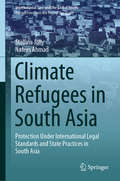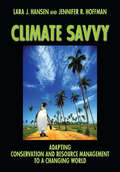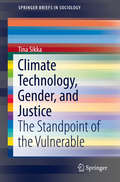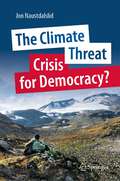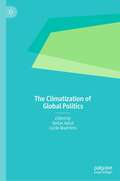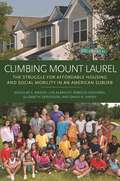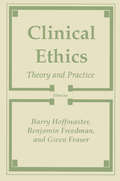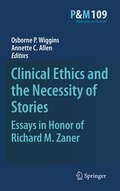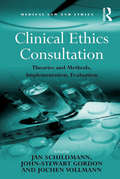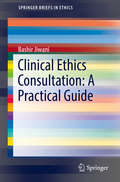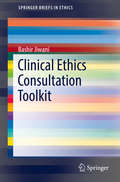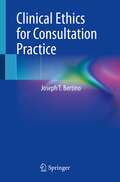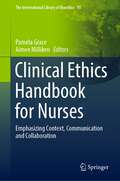- Table View
- List View
Climate Protection and Environmental Interests in Renewable Energy Law: Perspectives from Brazil and Germany
by Paula Galbiatti SilveiraThis book is about environmental and climate legal protection in the energy transition. The Paris Agreement has a binding commitment of holding the global temperature increase to 2°C while pursuing efforts to limit it to 1.5°C. To cope with the negative effects of climate changes and mitigate greenhouse gas emissions, one of the primary responses has been the deployment of renewable energy sources, transiting from fossil fuels to sustainable electricity production. However, renewable energy sources can also cause significant environmental impacts. Wind energy, for instance, can impact biodiversity, such as birds and bats, killing them when colliding with turbines and affecting their migration and nesting.This results in conflicts in environmental law. This book questions whether, in the energy transition, the generation of electricity from renewable sources to protect the climate is compatible with the protection of the environment, both interests in environmental law.To address this question, this book follows a legal-environmental perspective and assesses the common problem of solving those internal environmental conflicts in Brazilian and German law to understand and compare whether and how both legal systems solve the conflicts by compatibilizing the protection of the climate with other environmental interests. The legal analysis focuses on land-use planning and environmental licensing, assessing similarities and differences, and evaluating the results, identifying what one country can learn from the other.
Climate Refugees in South Asia: Protection Under International Legal Standards and State Practices in South Asia (International Law and the Global South)
by Stellina Jolly Nafees AhmadThis book addresses the forms of legal protection extended to people displaced due to the consequences of climate change, and who have either become refugees by crossing international borders or are climatically displaced persons (CDPs) in their own homelands. It explores the legal response of the South Asian Jurisdictions to these refugee-like situations, and also to what extent these people are protected under current international law. The book critically examines and assesses whether States have obligations to protect people displaced by climate change under international refugee law (IRL) and international climate change law (ICCL). It discusses the issue of climate migration in South Asia, analyzes the legal and judicial response initiated by South Asian nations, and also investigates the role of SAARC in relation to climate change and climate refugees. Drawing on the International Legal Standards and States’ Practices in South Asia regarding climate refugees, the book shows how IRL, ICCL, and IHRL (international human rights law) have been used to address and identify the gaps in the global legal protection framework concerning the contours of the normative debate on climate refugees, climate change displacement, migration, forced migration, susceptibility to climate change, typology of climate change-induced displacement, role of the SAARC and its municipal legal systems, approaches to climate change, human mobility and developing a hybrid regional law, or advocating a legal alternative of equal measure in a region characterized by diversity and multiculturalism. The book offers valuable takeaways for students, researchers, consultants, practitioners and policymakers alike.
Climate-Related Human Mobility in Asia and the Pacific: Interdisciplinary Rights-Based Approaches (Sustainable Development Goals Series)
by Matthew Scott Stellina Jolly Nafees AhmadThis open access book critically examines the policies and practices related to climate-related human mobility in Asia-Pacific and the legal and policy protection framework for climatically displaced migrants (CDMs) through an interdisciplinary human rights-based approach. While covering the policy and theoretical dimensions of mobility, it also evaluates the issue through empirical studies. The book illustrates how interdisciplinary rights-based approaches address and identify gaps in the protection framework for the region regarding dimensions of climate change displacement, migration, forced migration, susceptibility to climate change, and typology of climate change-induced displacement. Presenting multiple case scenarios, it recommends a legal mechanism based on human rights in a region brimming with variety and multiculturalism. Bringing together voices from the Asia-Pacific Academic Network on Disaster Displacement, the book examines issues that are immediately relevant in countries where they are living and working. In addition to academic perspective, the chapters also bring perspectives from positions held in national human rights institutions and government. They bring insight into lived experience and policy processes, seeking to avert, minimize, and address displacement, including through general disaster risk reduction and climate change adaptation initiatives, as well as specific initiatives around emergency preparedness for response and planned relocation and resettlement. The chapters examine diverse forms of human mobility, including displacement, planned relocation, and forced immobility. The combination of studies focusing on both sudden onset and slower onset movement is also distinctive. With a thorough understanding of the interdisciplinary rights-based approaches to the issue, students, researchers, policymakers, administrators, and all those engaged in studying these topics can quickly evaluate and appreciate how the rights of CDMs are protected on a national, regional, and international level in Asia-Pacific.
Climate Risk and Business: New Challenges for Organizations
by Anna DowbigginAddressing the urgency of radical decarbonization as a mitigative response to climate risk, this book explores how business can respond to the challenges of climate risk, through various transformational processes. Those processes involve cognitive transformations, organizational changes, climate risk integration into risk management practices, shifts in corporate reporting and disclosure as well as futuristic scenario-based planning beyond normal business planning cycles. Though much has already been written on corporate sustainability efforts, there is a greater need now for building mitigative capacity at the firm level, in alignment with shifting policy and regulatory regimes. Theoretical and empirical work on these areas is addressed in the novel thought experiment approach of this book. A research agenda for future work is provided.
Climate Savvy: Adapting Conservation and Resource Management to a Changing World
by Lara J. Hansen Jennifer R. HoffmanClimate change experts Lara Hansen and Jennifer Hoffman consider the implications of climate change for key resource management issues of our time—invasive species, corridors and connectivity, ecological restoration, pollution, and many others. How will strategies need to change to facilitate adaptation to a new climate regime? What steps can we take to promote resilience? Climate Savvy offers a wide-ranging exploration of how scientists, managers, and policymakers can use the challenge of climate change as an opportunity to build a more holistic and effective philosophy. Based on collaboration with a wide range of scientists, conservation leaders, and practitioners, the authors present general ideas as well as practical steps and strategies that can help cope with this new reality.
The Climate-Smart Agriculture Papers: Investigating The Business Of A Productive, Resilient And Low Emission Future
by Todd S. Rosenstock Andreea Nowak Evan GirvetzThis book is open access under a CC BY 4.0 license.This volume shares new data relating to Climate-Smart Agriculture (CSA), with emphasis on experiences in Eastern and Southern Africa. The book is a collection of research by authors from over 30 institutions, spanning the public and private sectors, with specific knowledge on agricultural development in the region discussed. The material is assembled to answer key questions on the following five topic areas: (1) Climate impacts: What are the most significant current and near future climate risks undermining smallholder livelihoods? (2) Varieties: How can climate-smart varieties be delivered quickly and cost-effectively to smallholders? (3) Farm management: What are key lessons on the contributions from soil and water management to climate risk reduction and how should interventions be prioritized? (4) Value chains: How can climate risks to supply and value chains be reduced? and (5) Scaling up: How can most promising climate risks reduction strategies be quickly scaled up and what are critical success factors? Readers who will be interested in this book include students, policy makers, and researchers studying climate change impacts on agriculture and agricultural sustainability.
Climate Technology, Gender, and Justice: The Standpoint Of The Vulnerable (Springerbriefs In Sociology Ser.)
by Tina SikkaThis book is the first to undertake a gendered analysis of geoengineering and alternative energy sources. Are either of these technologies sufficiently attendant to gender issues? Do they incorporate feminist values as articulated by the renowned social philosopher Helen Longino, such as empirical adequacy, novelty, heterogeneity, complexity and applicability to human needs? The overarching argument in this book contends that, while mitigation strategies like solar and wind energy go much further to meet feminist objectives and virtues, geoengineering is not consistent with the values of justice as articulated in Longino's feminist approach to science. This book provides a novel, feminist argument in support of pursuing alternative energy in the place of geoengineering. It provides an invaluable contribution for academics and students working in the areas of gender, science and climate change as well as policy makers interested in innovative ways of taking up climate change mitigation and gender.
The Climate Threat. Crisis for Democracy?
by Jon NaustdalslidA key point in the book is the need to focus more seriously at the energy problem as the real problem behind global warming. The failure of global climate policies to reduce CO2 emissions and halt climate change has led an increasing number of scientist and activists to lose confidence in democracy's ability to handle climate change and led them to look to more authoritarian measures to meet the problem. The book documents these trends, also from a historical perspective, criticize them and sketches more democratic alternatives.
The Climatization of Global Politics
This volume examines the process through which climate change is transforming global governance, as both an increasingly central issue on the international stage and an increasingly structured policy domain with its specific modes of governing, networks of actors, discourses, and knowledge practices. Collectively, the contributions aim to assess how and why climate change is becoming a dominant frame in international politics. In doing so, they also contribute to understanding the dynamics and drivers of climatization.As global warming progresses and efforts to mitigate and adapt intensify, living under a changing climate—or in a ‘new climate regime’ (Latour 2015)—increasingly appears as a central feature of ‘our’ new, and highly unequal, human condition in the Anthropocene. In other words, we firmly believe that climatization is here to stay. It is thus crucial to better understand this process, recognizing its problems and ambiguities, but also examining its transformative potential and identifying the conditions under which such potentials can be harnessed with a view to building a more effective and equitable climate politics. We think that the chapters in this book contribute to this endeavour.
Climbing Mount Laurel: The Struggle for Affordable Housing and Social Mobility in an American Suburb
by Douglas S. Massey Len Albright Rebecca Casciano Elizabeth Derickson David N. KinseyUnder the New Jersey State Constitution as interpreted by the State Supreme Court in 1975 and 1983, municipalities are required to use their zoning authority to create realistic opportunities for a fair share of affordable housing for low- and moderate-income households. Mount Laurel was the town at the center of the court decisions. As a result, Mount Laurel has become synonymous with the debate over affordable housing policy designed to create economically integrated communities. What was the impact of the Mount Laurel decision on those most affected by it? What does the case tell us about economic inequality?Climbing Mount Laurel undertakes a systematic evaluation of the Ethel Lawrence Homes--a housing development produced as a result of the Mount Laurel decision. Douglas Massey and his colleagues assess the consequences for the surrounding neighborhoods and their inhabitants, the township of Mount Laurel, and the residents of the Ethel Lawrence Homes. Their analysis reveals what social scientists call neighborhood effects--the notion that neighborhoods can shape the life trajectories of their inhabitants. Climbing Mount Laurel proves that the building of affordable housing projects is an efficacious, cost-effective approach to integration and improving the lives of the poor, with reasonable cost and no drawbacks for the community at large.
Climbing Mount Laurel: The Struggle for Affordable Housing and Social Mobility in an American Suburb (PDF)
by Douglas S. Massey Len Albright Rebecca Casciano Elizabeth Derickson David N. KinseyUnder the New Jersey State Constitution as interpreted by the State Supreme Court in 1975 and 1983, municipalities are required to use their zoning authority to create realistic opportunities for a fair share of affordable housing for low- and moderate-income households. Mount Laurel was the town at the center of the court decisions. As a result, Mount Laurel has become synonymous with the debate over affordable housing policy designed to create economically integrated communities. What was the impact of the Mount Laurel decision on those most affected by it? What does the case tell us about economic inequality?Climbing Mount Laurel undertakes a systematic evaluation of the Ethel Lawrence Homes--a housing development produced as a result of the Mount Laurel decision. Douglas Massey and his colleagues assess the consequences for the surrounding neighborhoods and their inhabitants, the township of Mount Laurel, and the residents of the Ethel Lawrence Homes. Their analysis reveals what social scientists call neighborhood effects--the notion that neighborhoods can shape the life trajectories of their inhabitants. Climbing Mount Laurel proves that the building of affordable housing projects is an efficacious, cost-effective approach to integration and improving the lives of the poor, with reasonable cost and no drawbacks for the community at large.
The Clinic and the Court: Law, Medicine and Anthropology (Cambridge Studies in Law and Society)
by Tobias Kelly Ian Harper Harper, Ian and Kelly, Tobias and Khanna, Akshay Akshay KhannaLaw and medicine can be caught in a tight embrace. They both play a central role in the politics of harm, making decisions regarding what counts as injury and what might be the most suitable forms of redress or remedy. But where do law and medicine converge and diverge in their responses to and understandings of harm and suffering? Using empirical case studies from Europe, the Americas and Africa, The Clinic and the Court brings together leading medical and legal anthropologists to explore this question.
The Clinic and the Court: Law, Medicine and Anthropology (Cambridge Studies in Law and Society)
by Tobias Kelly Ian Harper Akshay KhannaLaw and medicine can be caught in a tight embrace. They both play a central role in the politics of harm, making decisions regarding what counts as injury and what might be the most suitable forms of redress or remedy. But where do law and medicine converge and diverge in their responses to and understandings of harm and suffering? Using empirical case studies from Europe, the Americas and Africa, The Clinic and the Court brings together leading medical and legal anthropologists to explore this question.
Clinical Aspects of Sexual Harassment and Gender Discrimination: Psychological Consequences and Treatment Interventions
by Sharyn Ann LenhartThis book addresses the psychological impact of sexual harassment and gender discrimination from both a clinical and theoretical perspective, whereas previous literature on the topic has emphasized legal and employment consequences. To start, Lenhart provides a comprehensive summary and integration of existing literature and discusses relevant aspects of the workplace and legal environments. The second portion of the book deals with the psychodynamics of sexual harassment and gender discrimination, placing these violations in proper psychological perspective, along the same lines as rape, battering and other forms of gender-based abuse. The wide spectrum of psychological consequences of discrimination will be discussed and an effective and integrative model for intervention and treatment will be presented.
Clinical Aspects of Sexual Harassment and Gender Discrimination: Psychological Consequences and Treatment Interventions
by Sharyn Ann LenhartThis book addresses the psychological impact of sexual harassment and gender discrimination from both a clinical and theoretical perspective, whereas previous literature on the topic has emphasized legal and employment consequences. To start, Lenhart provides a comprehensive summary and integration of existing literature and discusses relevant aspects of the workplace and legal environments. The second portion of the book deals with the psychodynamics of sexual harassment and gender discrimination, placing these violations in proper psychological perspective, along the same lines as rape, battering and other forms of gender-based abuse. The wide spectrum of psychological consequences of discrimination will be discussed and an effective and integrative model for intervention and treatment will be presented.
Clinical Bioethics: A Search for the Foundations (International Library of Ethics, Law, and the New Medicine #26)
by C. ViaforaA theory of Clinical Bioethics based on the integration of the moral logic of health care practice ("internal morality") and the larger social concerns and processes ("external morality") Clinical Bioethics. A Search for the Foundations compares major theoretical models in the foundation of clinical bioethics and explains medicine as a normative practice. The goals of medicine are discussed with particular reference to the subjectivisation of health and the rationalisation of health care institutions. This volume provides a consistent reconstruction of bioethical judgment both at the level of epistemological statute and institutional context, i.e. clinical ethics committees and clinical ethics consultation.
The Clinical Encounter: The Moral Fabric of the Patient-Physician Relationship (Philosophy and Medicine #14)
by Earl E. ShelpThe encounter between patient and physician may be characterized as the focus of medicine. As such, the patient-physician relationship, or more accurately the conduct of patients and physicians, has been the subject of considerable comment, inquiry, and debate throughout the centuries. The issues and concerns discussed, apart from those more specifically related to medical theory and therapy, range from matters of etiquette to profound questions of philosophical and moral interest. This discourse is impressive with respect both to its duration and content. Contemporary scholars and laypeople have made their contribution to these long-standing discussions. In addition, they have actively addressed those distinctively modern issues that have arisen as a result of increased medical knowledge, improved technology, and changing cultural and moral expectation. The concept of the patient-physician rela tionship that supposedly provides a framework for the conduct of patients and physicians seemingly has taken on a life of its own, inviolable, and subject to norms particular to it. The essays in this volume elucidate the nature of the patient-physician relationship, its character, and moral norms appropriate to it. The purpose of the collection is to enhance our understanding of that context, which many consider to be the focus of the entire medical enterprise. The con tributors have not engaged in apologetics, polemics, homiletics, or em piricism.
Clinical Ethics: Theory and Practice (Contemporary Issues in Biomedicine, Ethics, and Society)
by Barry Hoffmaster Benjamin Freedom Gwen FraserThere is the world of ideas and the world of practice; the French are often for sup pressing the one and the English the other; but neither is to be suppressed. -Matthew Arnold The Function of Criticism at the Present Time From its inception, bioethics has confronted the need to reconcile theory and practice. At first the confrontation was purely intellectual, as writers on ethical theory (within phi losophy, theology, or other humanistic disciplines) turned their attention to topics from the world of medical practice. Recently the confrontation has grown more intense. The ap pointment of clinical ethicists in hospitals and other health care settings is an accelerating trend in North America. Concomitantly, those institutions involved in training peo ple in clinical ethics have added organized exposure to the world of practice , in the form of placement requirements, to the normal academic course load. In common with other dis ciplines, bioethics has begun to see clinical training as a con dition of didactic theory and apprenticeship.
Clinical Ethics and the Necessity of Stories: Essays in Honor of Richard M. Zaner (Philosophy and Medicine #997)
by Osborne P. Wiggins and Annette C. AllenThis collection of articles honors the work of Richard Zaner, a distinguished philosopher who has worked for over twenty years as an ethics consultant at Vanderbilt University Medical Center. His work in the clinical setting, especially the use of narrative in understanding what is going on in this setting is the focus of some of the papers, others relate his methodology and phenomenological approach to the more standard bioethical problemata and approaches. The essential questions: what then is the role of the philosopher turned medical ethicists? Is medical ethics a form of applied philosophy, or is it also a form of therapy? distinguish Zaner's phenomenology from hermeneutical philosophy.
Clinical Ethics Consultation: Theories and Methods, Implementation, Evaluation
by John-Stewart GordonThis volume brings together researchers from different European countries and disciplines who are involved in Clinical Ethics Consultation (CEC). The work provides an analysis of the theories and methods underlying CEC as well a discussion of practical issues regarding the implementation and evaluation of CEC. The first section deals with different possible approaches in CEC. The authors explore the question of how we should decide complex cases in clinical ethics, that is, which ethical theory, approach or method is most suitable in order to make an informed ethical decision. It also discusses whether clinical ethicists should be ethicists by education or rather well-trained facilitators with some ethical knowledge. The second chapter of this book focuses on practical aspects of the implementation of CEC structures. The analysis of experienced clinical ethicists refers to macro and micro levels in both developed and transitional countries. Research on the evaluation of CEC is at the centre of the final chapter of this volume. In this context conceptual as well as empirical challenges with respect to a sound approach to judgements about the quality of the work of CECs are described and suggestion for further research in this area are made. In summary this volumes brings together theorists and healthcare practitioners with expertise in CEC. In this respect the volume serves as good example for a multi- and interdisciplinary approach to clinical ethics which combines philosophical reasoning and empirical research.
Clinical Ethics Consultation: Theories and Methods, Implementation, Evaluation
by John-Stewart GordonThis volume brings together researchers from different European countries and disciplines who are involved in Clinical Ethics Consultation (CEC). The work provides an analysis of the theories and methods underlying CEC as well a discussion of practical issues regarding the implementation and evaluation of CEC. The first section deals with different possible approaches in CEC. The authors explore the question of how we should decide complex cases in clinical ethics, that is, which ethical theory, approach or method is most suitable in order to make an informed ethical decision. It also discusses whether clinical ethicists should be ethicists by education or rather well-trained facilitators with some ethical knowledge. The second chapter of this book focuses on practical aspects of the implementation of CEC structures. The analysis of experienced clinical ethicists refers to macro and micro levels in both developed and transitional countries. Research on the evaluation of CEC is at the centre of the final chapter of this volume. In this context conceptual as well as empirical challenges with respect to a sound approach to judgements about the quality of the work of CECs are described and suggestion for further research in this area are made. In summary this volumes brings together theorists and healthcare practitioners with expertise in CEC. In this respect the volume serves as good example for a multi- and interdisciplinary approach to clinical ethics which combines philosophical reasoning and empirical research.
Clinical Ethics Consultation: A Practical Guide (SpringerBriefs in Ethics)
by Bashir JiwaniThis book provides a careful and comprehensive, step-by-step method for providing clinical ethics consultation. This Guide can be applied in almost any healthcare setting and takes the reader from establishing an intake process and developing strategies for interviewing those involved in the situation, to undertaking a consultation meeting and following up on a clinical consult. The book is an invaluable resource to any clinical ethicist, or committee or consult team member who is seeking to provide their service with rigour and quality. Written in simple language, the book explores ideas and concepts that will help the reader to understand, think through, and ultimately offer useful ethical consultation when facing ethically challenging issues.
Clinical Ethics Consultation Toolkit (SpringerBriefs in Ethics)
by Bashir JiwaniThis workbook is a companion to Clinical Ethics Consultation: A Practical Guide to Changing Culture, Building Capacity and Solving Problems Case by Case. The Toolkit lays out the process for clinical ethics consultation in a series of steps within five phases: Pre-Consult, Interviews, Mid-Consult, Consult meeting(s), and Post-Consult. For each step, the Toolkit provides directions for how to complete it, tips for success, and worksheets for capturing data and analysis. The Clinical Ethics Consultation Toolkit is the playbook from which clinical ethics consultants can draw methods and strategies for effectively delivering ethics consultation.
Clinical Ethics for Consultation Practice
by Joseph T. BertinoThis book provides a robust analysis of the history of clinical ethics, the philosophical theories that support its practice, and the practical institutional criteria needed to become a practicing clinical ethicist.Featuring cases and a step-by-step approach, this book combines knowledge points associated with moral philosophy and medicine with general skill objectives for ethics consultants. The book aids in developing analytic moral reasoning skills for clinical ethicists, fostering the comprehensive education and professional development of clinical ethics consultants. In addition, it offers key components of how an ethics consultation curriculum manifest in an educational venue for clinical ethicists are illustrated. Adaptable and relevant for educating multiple disciplines in health care, this resource enables ethicists to understand the philosophical foundations and practical application of clinical ethics.
Clinical Ethics Handbook for Nurses: Emphasizing Context, Communication and Collaboration (The International Library of Bioethics #93)
by Pamela Grace Aimee MillikenThis handbook provides tools for nurse educators, ethics educators, practicing nurses and allied health professionals for developing confidence and skill in ethical decision making in interdisciplinary settings such as acute and chronic care hospitals and clinics. It is useful for all healthcare personnel who face ethical issues in the course of their work and who work with nurses to resolve these issues. While the content is based on a US context, the concerns of nurses internationally are discussed and emphasized. Nurses working in acute and chronic care settings face many obstacles to providing good care and are often the first line of defense related to patient safety and meeting the needs of patients and their families. Some of the obstacles to optimal patient care are institutional, some sociocultural, and others the result of inadequate communication. Evidence points to the idea that while nurses do have the knowledge and skills to address practice problems of various sorts, they may not be confident in their skills of ethical decision making and advocacy actions. This is a resource to develop moral agency on behalf of individuals and to address broader barriers to good care raised at the local, community, or social levels.

